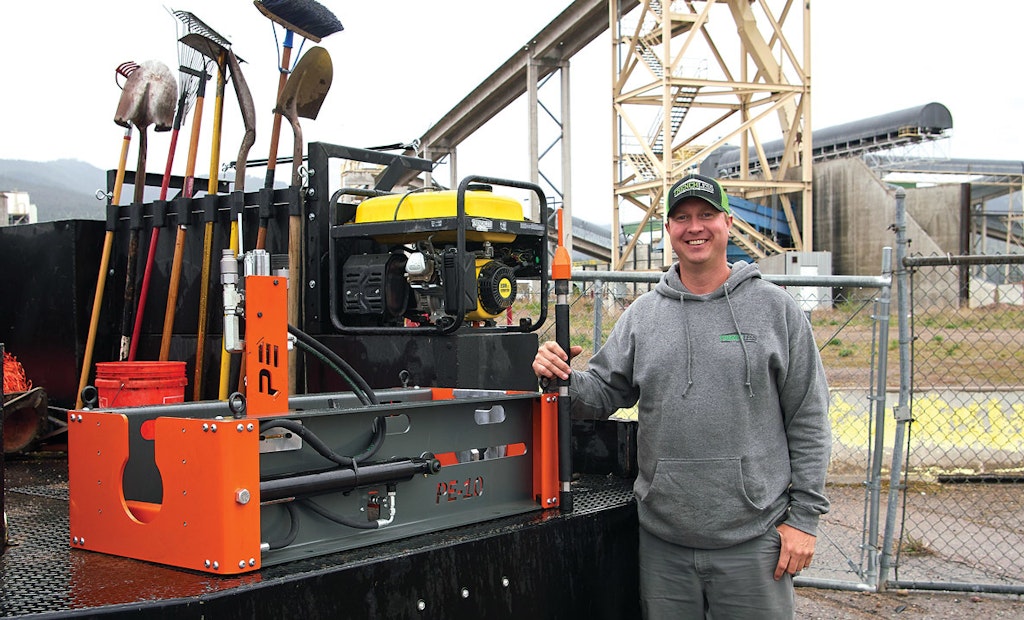
Kurt Fossen, owner of Trenchless Solutions in Missoula, Montana, uses a PE-10 machine from PE Equipment for pipeline replacement on jobs where HDD or pipe bursting aren’t good options.
Interested in Relining/Rehab?
Get Relining/Rehab articles, news and videos right in your inbox! Sign up now.
Relining/Rehab + Get AlertsWhen faced with installing new pipelines in some of the rockiest topography around, trenchless pipe rehabilitation contractor Kurt Fossen knows the path of least resistance is the route best taken.
That’s why his company, Trenchless Solutions in Missoula, Montana, invested in a PE-10 machine, built by PE Equipment. The machine is designed to pull or push existing waterline pipes on job sites where pipe bursting or horizontal directional drilling aren’t good options. At the same time, the machine also pulls in a new pipe behind the pipe being replaced.
Better yet, this machine is a Swiss Army knife of sorts, also capable of pipe bursting and directional drilling by just changing out attachments on the same modular chassis.
“It’s a very versatile machine,” Fossen says.
“When it comes to customers, I’m a ‘yes’ guy. When somebody calls us with a problem, I like to be able to take care of them. I want as many tools as possible in my hands in order to rehab these lines with minimal disturbance to customers’ properties. If we can’t be true to our company’s trenchless name, I feel like we’re cheating them. Our goal is to be the go-to guys for trenchless rehab of underground utility lines. And a machine like this one help us do that because we can use it in applications where we have difficulty using other machines.”
The company does trenchless pipe rehab work primarily for gas, water and sewer utilities. “Any pipe in the ground is fair game,” he says.
A challenging project
A good case in point was a tricky job the company tackled in fall 2019 at an elementary school connected to a middle school in Missoula. Each school suffered a waterline break in 2-inch copper lines.
Traditional line replacement in the elementary school would have required cutting about a 30-inch-wide, roughly 60-foot-long stretch of concrete floor through a classroom and over to a mechanical room. At the middle school, the repair would’ve required a 35- to 40-foot-long cut over to another mechanical room.
“That’s a lot of concrete to tear out, not to mention all the dust, noise and disruption,” says Fossen, who established his business in 2016 and has seven employees. “It probably would’ve taken us a week to do each line repair that way.”
Pipe bursting wasn’t an option because even the smallest bursting heads still were too big for the existing 2-inch diameter copper pipes. And directional drilling wasn’t a good option, either, he says.
“The ground conditions were really nasty. And once you start drilling, you’re a slave to the ground conditions; plus you never know what you’ll find, whether it’s an old vault or even buried cars, which we’ve run into before. If there’s already a pipe in the ground and you can use that to bring in a new one, it’s much more straightforward than drilling.”
Minimal disruption
So that’s exactly what the Trenchless Solutions crew did. After digging a pit at each school for the PE-10, the crew also cut a roughly 16-inch-diameter hole in each mechanical room to access the water lines. Then in each case, they fed the PE-10’s cable through the existing pipe from the pit to the mechanical room, then attached a special tip that affixed to the end of the copper pipe.
At the same time, they attached a roll of 3-inch-diameter HDPE pipe to the same tip. Then the PE-10 finished off the job by pulling out the existing pipe into the pit, where the operator cut it off in sections as it emerged and pulled in the HDPE pipe in place behind it. Think of it as similar to pipe bursting, but without the bursting, Fossen explains.
“It took about one day to install each of the new water lines. I can say with 100% confidence that we did it with far less disruption than anyone else could have. In one building, we went under a computer lab while kids were in class — there was no need to shut down the school. The PE-10 almost paid for itself with that one job.”
Happy customers
The company bought the machine nearly two years ago. It’s available as just a pipe bursting machine or just a rod pusher/puller for $16,500 or as both a pipe burster and a rod pusher/puller for $21,000. The directional-drilling capability costs $14,000 more.
The PE-10 is easy to operate and service — no complicated electronics or other hurdles to jump, Fossen says.
“It’s a very well-engineered machine. We have very experienced bursting and drilling guys, so it didn’t take them long to get the hang of it. But it’s still very simple to operate.”
Significant productivity increases allow crews to do more jobs than they otherwise could, helping the company make more money.
“It’s all about better efficiency,” Fossen says. “Plus we don’t have to do all that topside restoration work that comes with open-cut jobs. For a contractor who doesn’t have any other equipment, this machine is great because of its versatility. And for a company like ours, that already owns a lot of equipment, it’s still a win when we run into specialized situations.”
Fossen says this ultimately leads to happier customers “because of the minimal impact on their yards, which in turn generates word-of-mouth referrals,” he adds. “It’s created a grassroots referral program for us. I’d say it’s been a spectacular investment … we rolled the dice and hit a home run.”





